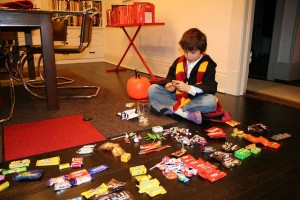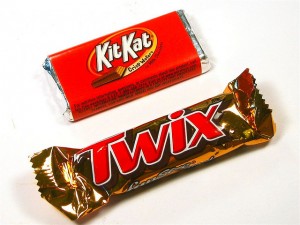Trick-or-treat: Tomorrow is Halloween Posted by Gabriele on Oct 30, 2014 in Culture

Image “Halloween Candy” by terren in Virginia on Flickr.com shows a bowl of American Halloween candy.
Tomorrow is the holiday of Halloween in American; so tomorrow night Americans of all ages will be dressing up in costumes, going to parties, and children will be getting ready to go get some candy!
You may already have figured this out, but the holiday of Halloween has come to be synonymous with candy for most Americans. Although there are many Halloween traditions, it seems most of them now revolve around candy. Certainly for most American children, Halloween = candy.
This candy obsession all started with the phrase “trick-or-treat.” In decades past American children used to go houses, dressed up in costume (so people wouldn’t know who they were) and ask if the person at that house wanted to have a trick (trick = an act intended to scare or surprise someone) played on them, or if the person would prefer to give the children a treat (treat = something sweet to eat). People would choose a trick or a treat, and usually people would choose to give a treat because they didn’t want to have a trick played on them. Treats in the past were not always candy, they were usually food, but could be homemade cookies or a caramel apple. Today, when children go door-to-door dressed up in costumes on Halloween they don’t usually have a trick in mind to play on anyone; they are mostly just hoping for candy. Some children don’t even know what the phrase “trick-or-treat” really means, but now you do.
Nowadays Halloween candy is big business in America. There are a lot of children who go trick-or-treating on Halloween night and so most people buy candy to give out to them. People who live in neighborhoods where there are a lot of children usually buy multiple bags of candy to hand out. It is fun to see little children dressed up and excited about Halloween, even if it is just because they want candy.
Halloween candy usually is made in small sizes. Very few people hand out full size candy bars. Most people give “miniature” or “mini” candy bars. Some people give out “snack size” or “fun size” candy bars. Mini candy bars are very small and snack size are about ½ to 1/3 the size of a regular candy bar. The candy in the picture above is “snack size.” Some people hand out “full size” or regular sized candy bars, but that is rare. By the end of Halloween night, most children have a bag full of candy, so it is probably best that they are mostly getting little candy bars!

Image “Halloween Candy” by Nina Hale on Flickr.com shows a child looking at their candy from trick-or-treating.
For most children, the best part of trick-or-treating is going home and looking at all the candy they have been given. I remember as a child I would love to lay out all my candy and decide which pieces I liked and which I didn’t like, then I would try to trade the piece of candy I didn’t like with my brothers. The picture above shows a boy with all his Halloween candy laid out and organized. As an adult the best part of Halloween is getting to eat all the left over candy that wasn’t handed out to trick-or-treaters or eating your children’s candy after they have gone to bed 🙂
Happy Halloween everyone, even if you don’t dress up or go trick-or-treating tomorrow, I hope you enjoy a piece of candy in honor of this sugary holiday!

Build vocabulary, practice pronunciation, and more with Transparent Language Online. Available anytime, anywhere, on any device.
About the Author: Gabriele
Hi there! I am one of Transparent Language's ESL bloggers. I am a 32-year-old native English speaker who was born and raised in the United States. I am living in Washington, DC now, but I have lived all over the US and also spent many years living and working abroad. I started teaching English as a second language in 2005 after completing a Master's in Applied Linguists and a Certificate in English Language Teaching to Adults' (CELTA). Since that time I have taught ESL in the United States at the community college and university level. I have also gone on to pursue my doctorate in psychology and now I also teach courses in psychology. I like to stay connected to ESL learners around the world through Transparent Languages ESL Blog. Please ask questions and leave comments on the blog and I will be sure to answer them.




